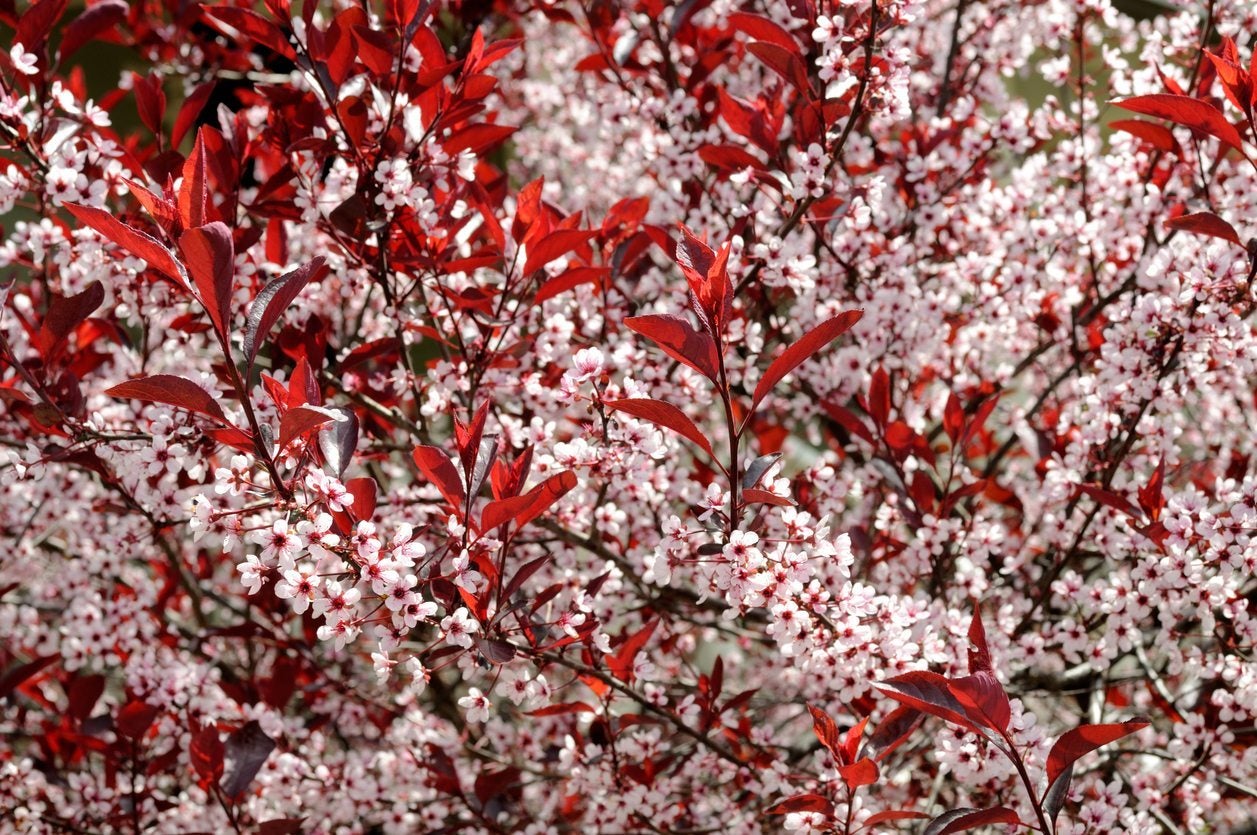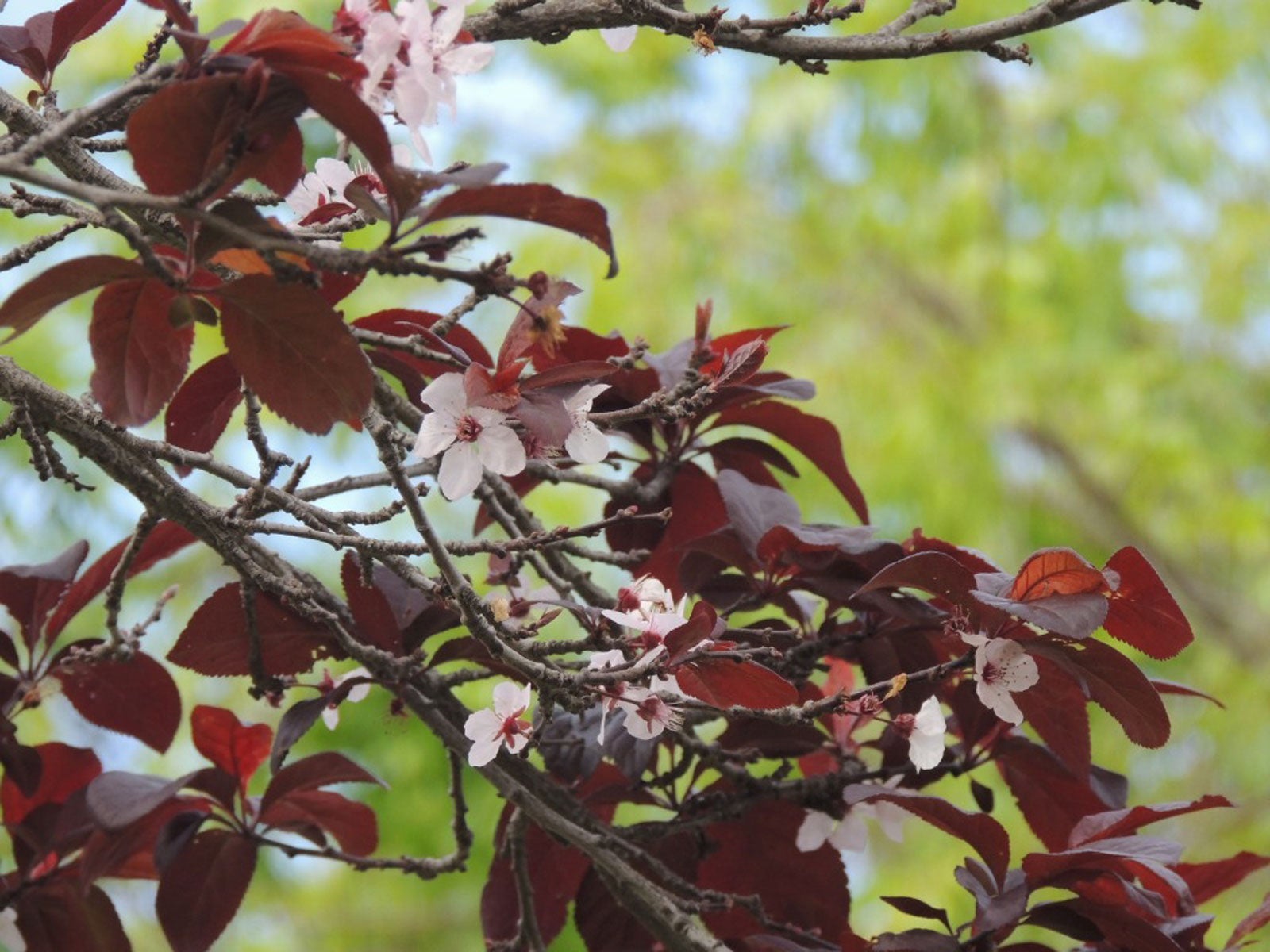Sand Cherry Plant Care: How To Grow A Purple Leaf Sand Cherry

Plum leaf sand cherry, also referred to as purple leaf sand cherry plants, is a medium sized ornamental shrub or small tree that when mature reaches a height of approximately 8 feet (2.5 m.) tall by 8 feet (2.5 m.) wide. This easy care plant makes a great addition to the landscape.
About Plum Leaf Sand Cherry
Purple leaf sand cherry (Prunus x cistena) is a member of the Rose family. Prunus is Latin for ‘plum' while cistena is the Sioux word for ‘baby' in reference to its smallish size. The “x” is indicative of the shrub's hybridism. This Prunus hybrid is useful as an ornamental specimen due to its beautiful red, maroon, or purple foliage. The shrub grows at a moderate rate and is suitable in USDA zones 2-8. The parent plants of sandcherry bush hail from Western Asia (Prunus cerasifera) and the Northeastern United States (Prunus pumila). This purplish-red leafed plant has an oval growth habit gradually maturing into an arched form and opening out from the center of the shrub. The stunning 2-inch (5 cm.) long, serrated foliage emerges crimson-purple and remains throughout the summer, gradually changing to a green-bronze hue in the fall. Around early spring, the plant's pink buds open into whitish-pink flowers - the same time as the red foliage. The innocuous blooms become small black-purple fruit barely noticeable without contrast to the purple foliage in July. The multiple gray-brown trunks are prone to trunk fissuring and cankers, which ooze sap.
How to Grow a Purple Leaf Sand Cherry
This specimen is urban tolerant and establishes rapidly to lend a brilliant pop of color to the landscape. So how do you grow a purple leaf sand cherry? Sand cherry is readily available through the local nursery and/or propagated via rooted stem cuttings. Sand cherry is sensitive to being transplanted in the autumn, so extra care should be taken in amending the soil, fertilizing, mulching heavily, and watering thoroughly. Ideally, you should plant the purple leaf sand cherry in full to partial sun exposure in moist, well-draining soil. However, the sand cherry bush is adaptable to lesser soils, drought, heat, and over aggressive pruning.
Sand Cherry Plant Care
Because, the sand cherry is a member of the Rose family, it is susceptible to several diseases, such as trunk canker, and pests, like borers and Japanese beetle assaults in mid-summer. It also has a short lifespan at between 10 to 15 years primarily due to assault by pests or diseases. Other than these issues, the sand cherry plant care is relatively fuss free and is tolerant of a variety of conditions - hardy in cold winters and hot summers. Prune the sand cherry bush to remove heavy branching that will weigh the plant down. It can even be pruned into a formal hedge or used in borders, at entranceways or in group plantings.
Gardening tips, videos, info and more delivered right to your inbox!
Sign up for the Gardening Know How newsletter today and receive a free copy of our e-book "How to Grow Delicious Tomatoes".

Amy Grant has been gardening for 30 years and writing for 15. A professional chef and caterer, Amy's area of expertise is culinary gardening.
-
 4 Superfast Composting Methods: Turn Waste Into Garden Gold In 30 Days Or Less
4 Superfast Composting Methods: Turn Waste Into Garden Gold In 30 Days Or LessTry the fastest composting methods to turbocharge your pile and transform kitchen scraps and garden waste into finished compost in just a few weeks.
By Mary Ellen Ellis
-
 Best Spider Plant Soil – Complete Soil Guide And Expert Tips For Keeping Plants Happy
Best Spider Plant Soil – Complete Soil Guide And Expert Tips For Keeping Plants HappySpider plants are fun and easy plants to grow, but what is the best soil for a spider plant? Selecting the right soil is important so they can thrive.
By Bonnie L. Grant
-
 Propagating Sand Cherry Trees: How To Propagate A Sand Cherry
Propagating Sand Cherry Trees: How To Propagate A Sand CherryAlso known as Bessey cherry, propagating a sand cherry plant isn't a difficult task, and there are several effective ways to propagate sand cherry trees. Click this article to learn how to propagate a sand cherry for your garden.
By Mary H. Dyer
-
 Pruning Plum Leaf Sand Cherry: When And How To Prune A Purple Leaf Sand Cherry
Pruning Plum Leaf Sand Cherry: When And How To Prune A Purple Leaf Sand CherryPurple leaf sand cherry care involves regular pruning. Read this article for tips on how to prune a purple leaf sand cherry. Click here for more info.
By Mary H. Dyer